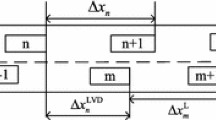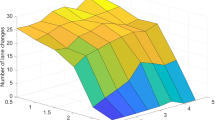Abstract
The drivers in actual traffic differ in the aggressiveness in driving behaviors, which will finally be reflected in the interaction between vehicles and fluctuations in flows. In this paper, we try to study the effect of driving aggressiveness on the traffic stability by proposing an extended microscopic car-following model, in which the optimal velocity is reconstructed to divide the drivers in traffic system into two groups according to driving aggressiveness of each individual. The stability condition of the proposed model is derived to explore its ability against a small perturbation by use of the linear stability theory. We obtain the neutral stability lines for different percentages of drivers with a higher driving aggressiveness, finding that the traffic flow trends to stable with the increase in the percentage for higher driving aggressiveness drivers when the average headway is less than a critical value or greater than another critical value, but when the average headway falls into the intermediate range between the two critical values, the traffic flow becomes more and more unstable with increase in the percentage of drivers with a higher driving aggressiveness. Finally, numerical simulations are conducted to verify these theoretical results and examine how the percentage of vehicles driven by higher driving aggressiveness drivers affects the traffic flux of the vehicle system.









Similar content being viewed by others
References
Greenberg, H.: An analysis of traffic flow. Oper. Res. 7, 86–106 (1959)
Helbing, D.: Fundamentals of traffic flow. Phys. Rev. E 55, 3735–3738 (1997)
Payne, Harold J.: Models of freeway traffic and control. Math. Methods Public Syst. 1, 51–61 (1971)
Kerner, B.S., Rehborn, H.: Experimental properties of phase transitions in traffic flow. Phys. Rev. Lett. 79, 4030–4033 (1997)
Gavrilov, K.L.: Microstructure and microdynamics of uninterrupted traffic flow. Phys. Rev. E 56, 4860–4863 (1997)
Nagatani, T., Nakanishi, K.: Delay effect on phase transitions in traffic dynamics. Phys. Rev. E 57, 6415–6421 (1998)
Bando, M., Hasebe, K., Nakayama, A.: Dynamical model of traffic congestion and numerical simulation. Phys. Rev. E 51, 1035–1042 (1995)
Nagatani, T.: Vehicular traffic through a self-similar sequence of traffic lights. Phys. A 386, 381–387 (2007)
Ge, H.X., Dai, S.Q., Dong, L.Y., Xue, Y.: Stabilization effect of traffic flow in an extended car-following model based on an intelligent transportation system application. Phys. Rev. E 70, 066134 (2004)
Ge, H.X., Meng, X.P., Ma, J., Lo, S.M.: An improved car-following model considering influence of other factors on traffic jam. Phys. Lett. A 377, 9–12 (2012)
Li, X.L., Song, T., Kuang, H., Dai, S.Q.: Phase transition on speed limit traffic with slope. Chin. Phys. B 17, 3014–3020 (2008)
Li, X.L., Kuang, H., Song, T., Dai, S.Q., Li, Z.P.: New insights into traffic dynamics: a weighted probabilistic cellular automaton model. Chin. Phys. B 17, 2366–2372 (2008)
Cheng, R.J., Li, Z.P., Zheng, P.J., Ge, H.X.: The theoretical analysis of the anticipation lattice models for traffic flow. Nonlinear Dyn 76, 725–731 (2014)
Peng, G.H., Cheng, R.J.: A new car-following model with the consideration of anticipation optimal velocity. Phys. A 392, 3563–3569 (2013)
Han, X.L., Ouyang, C., Song, T., Dai, S.S.: The homotopy analysis method for a class of jamming transition problem in traffic flow. Acta Phys. Sin. 62, 170203 (2013)
Han, X.L., Jiang, C.Y., Ge, H.X., Dai, S.Q.: A modified coupled map car-following model based on application of intelligent transportation system and control of traffic congestion. Acta Phys. Sin. 56, 4383–4392 (2007)
Tian, H.H., Xue, Y., Kan, S.J., Liang, Y.J.: Study on the energy consumption using the cellular automaton mixed traffic model. Acta Phys. Sin. 58, 4506–4513 (2009)
Peng, G.H., Sun, D.H.: Multiple car-following model of traffic flow and numerical simulation. Chin. Phys. B 18, 5420–5430 (2009)
Wei, S., Yu, X.: Study on stability and energy consumption in typical car-following models. Phys. A 381, 399–406 (2007)
Treiber, M., Hennecke, A., Helbing, D.: Congested traffic states in empirical observations and microscopic simulations. Phys. Rev. E 62, 1805–1824 (2000)
Chowdhury, D., Santen, L., Schadschneider, A.: Statistical physics of vehicular traffic and some related systems. Phys. Rep. 329, 199–329 (2000)
Wu, C.X., Zhang, P., Wong, S.C.: Steady-state traffic flow on a ring road with up- and down-slopes. Phys. A 403, 85–93 (2014)
Zhu, W.X., Yu, R.L.: A new car-following model considering the related factors of a gyroidal road. Phys. A 393, 101–111 (2014)
Nagatani, T.: Multiple jamming transitions in traffic flow. Phys. A 290, 501–511 (2001)
Acknowledgments
This work was supported by the Natural Science Foundation of China under Grant No. 61202384, the Fundamental Research Funds for the Central Universities under Grant No. 0800219198, the Natural Science Foundation of Shanghai under Grant No. 12ZR1433900, the National High Technology Research and Development Program of China under Grant No. 2012AA112801, and the Scientific Research and Development Program of China Railway Corporation under Grant No. 2013X016-B.
Author information
Authors and Affiliations
Corresponding author
Rights and permissions
About this article
Cite this article
Li, Z., Liu, L., Xu, S. et al. Impact of driving aggressiveness on the traffic stability based on an extended optimal velocity model. Nonlinear Dyn 81, 2059–2070 (2015). https://doi.org/10.1007/s11071-015-2125-y
Received:
Accepted:
Published:
Issue Date:
DOI: https://doi.org/10.1007/s11071-015-2125-y




